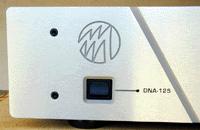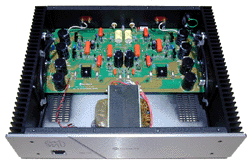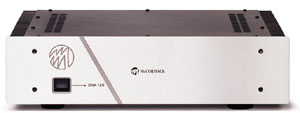McCormack DNA-125 Amplifier
| McCormack DNA-125 Amplifier |
|
Jim Merod |
|
1 August 2000 |
Output Power: 125 watts per channel into 8 ohms and 200 watts per channel into 4
ohms, both channels driven from 20Hz to 20 kHz at less than 1% THD.
Input Impedance: 100 kOhms
Input Sensitivity: 1.0 Vrms
Voltage Gain: 30 dB
Frequency Response: -3 dB @ .5 Hz, 200 kHz
Signal to Noise Ratio: 98 dB
Harmonic Distortion (1 kHz, 8-ohm load): .05%
Signal Polarity: (“Absolute Phase”): Non-inverting
Power Requirements (117 V/60 HZ): 0.65 Amps/80 watts
@ idle; 3.2 Amps/400 watts @ clipping (8 ohms)
Dimensions: 19″ W × 4 9/16″ H × 15″ D
Shipping Weights: 37 lbs.
Price: $1695.
Manufacturer:
McCormack Audio Corporation of Virginia
Inc., 2733 Merrilee Drive
Fairfax, VA 22031
Phone: 703-573-9665
Fax: 703-573-9667
Web: www.McCormackAudio.com
“There is no amplifier that I am aware of that delivers such a combination of virtues at such a modest price. The McCormack line is, and has long been, a standard of genuine audio value in a high-priced, often inflated market.”
When the brand new McCormack DNA-125 arrived at Chez BluePort, its deep burnished aluminum housing gleamed in the afternoon California calm with evil intention. I have been a fan of McCormack gear a long time. Several pieces are central to my daily work as a sound engineer. For four or five years, the McCormack Headphone Drive has made professional life bearable on the road as I plunge, soul first, ears & fingers at the ready, recording jazz and blues in every imaginable hot spot and godforsaken musical backwater. Last week, it was Bill Magee’s Blues Band at Blind Melons in Pacific Beach–the week before, Tierney Sutton at Monteleone’s in Los Angeles, and the next night, Carl Saunders Sextet at Steamers Jazz Club in Fullerton.

Enter this on-location-recording engineer into one of his mastering enclaves. Turn on the new DNA-125 amplifier newly minted by McCormack of Virginia. Let it warm up. Present it with raw unmastered music from the previous night. And sit back to hear what you’ve got.
The aftermath of live recording work is no less crucial to final success than the unfolding hours of stuffing 24-bit information onto tape in a club or concert hall. Mastering begins with scrupulous awareness of what you have to work with. Therefore, exceptional monitors and exceptional amplifiers are essential.
For five years or more, I have used a revised McCormack 0.5 amp in such work. Over the last two or three years, I have been in the presence of various original McCormack amplifiers (0.5s, 1.0s, and 2s) that have been given Steve McCormack’s remarkable upgrades. On dozens of occasions, the mastering of BluePort recordings has taken place with those highly uncolored, truly dynamic amplifiers in the signal path. McCormack amplifiers have a long track record of unvarnished musical truthfulness. Their character, as a consistent sonic virtue, is a combination of raw power, musical ease, wide spectral extension, and an utterly convincing sense of image placement, soundstage depth, and ambient retrieval.
There is no amplifier that I am aware of that delivers such a combination of virtues at such a modest price. The McCormack line is, and has long been, a standard of genuine audio value in a high-priced, often inflated market.
Enter, with hope written in code across its chassis, the new McCormack of Virginia DNA-125. This amp bears the understated good looks that have always characterized McCormack gear. DNA- 125 and DNA-225 amps stand in the direct line of their amplifier forebearers both sonically and aesthetically. The good news is that, visually, the new amps are appealing–an enhancement of exterior good looks. After weeks of careful listening, the rest of the good news is no less immediate and direct. These new amplifiers will rock your boat, your house, and your sturdy music-hungry soul.
When the DNA 125 appeared it was in slight need of some bias work, which designer-creator (all round musical and electronic genius) Steve McCormack took care of right away. This amp is only recently getting to dealer showrooms and my unit was, I believe, among the first off the production block.
Although, in its initial (misadjusted) condition, the amp was a trifle dark in its sonic presentation, I liked what I heard. The amp simply took its place between my Cabasse Baltic-Stromboli speakers and began to show off.
That may seem like a strange way to characterize a piece of audio gear. After all, we are dealing here with mute circuits that only spring to life when music is funneled through them. In moments of narcissism, I’d like to think that such brute instruments of musical mischief only become “real” when the sort of work that I do wakes them into action.
There may be a thin veneer of truth to such fantasy, but anyone familiar with audio electronics knows that every brand, each unit, any refinement (or tweak) alters the musical equation. My recording work stands ready to be made glorious or go down to defeat at the whim of an amplifier’s mood. I never underestimate the ability of amplifiers to tell the truth, “improve the truth,” or mangle the truth of musical signals.
In pursuit of knowledge about my recordings, I often play them (carefully selected pieces) on big audio reproduction rigs set up to startle the multitudes at trade shows, conventions, and the like. The experiment in hearing your own recordings riffed back at you from a dozen or more expensive stereo or surround sound systems can keep you humble, or alert you to useful things in your own work and in the sonic breeding of the systems you are listening to.
Amplifiers come in as many sonic flavors and shades of possible musical “truth” as there are amplifiers on the market. I am always amused at the notion of absolute “accuracy” in amplification–of explicit sonic transparency. I have not yet heard that mythical moment made incarnate.
“Perhaps, of all the words I can choose to characterize this McCormack amplifier, the one that most exactly fits it is the word “musical.” That can be a somewhat ambiguous term, so let me open it up a bit in relation to this little amplification giant.”
I have no doubt at all that some amplifiers own a curious, lovely way with music that can tickle your heart strings. Others have a startling way with strongly graphic sonic presentation. Others yet blend the two attitudes into a non-analytical yet not overly romantic audio world. Amplifiers that have impressed me the most over a long time have been those than carry enough sonic confidence to dig down deep into the music–into its most finely-wrought details–to deliver an explicit, vivid sense of musical nuance, and the nuances that are inscribed by the recording chain itself.
I doubt that many people will listen for such cues but, on amplifiers capable of these discriminations, if you are familiar with microphones and with microphone placement (and other technical aspects of recording and mastering), you can hear the signature of a specific microphone, even on a recording that you’ve never previously heard. If an amplifier has enough signal-resolving power, the smallest degrees of sonic information are unobtrusively revealed as part of the music.
Usually one hears significant micro-information only from very large amplifiers. I have recently heard large Audio Research and BAT amplifiers get the music right and, also, deliver such “sidebars” of sonic information.
 Enter the McCormack DNA 125. While this is not the biggest amp in the line, rated at 125 watts/channel into 8 ohms (200 watts into 4 ohms), it is plenty hefty. When I installed it, somewhat sadistically, in front of the unforgiving Apogee “Stage” speakers, which drop down to a 2-ohm load, the DNA 125 accounted itself very nicely though not as spectacularly as its bigger brother the DNA-225, but quite well, nonetheless.
Enter the McCormack DNA 125. While this is not the biggest amp in the line, rated at 125 watts/channel into 8 ohms (200 watts into 4 ohms), it is plenty hefty. When I installed it, somewhat sadistically, in front of the unforgiving Apogee “Stage” speakers, which drop down to a 2-ohm load, the DNA 125 accounted itself very nicely though not as spectacularly as its bigger brother the DNA-225, but quite well, nonetheless.
The test of the DNA-125 is not a brutal, somewhat iconoclastic load such as the Apogee “Stage” speakers. It is best carried out on a variety of speakers that many people will be familiar with: Vandersteen 2’s and 3s; Avalons; Silverline Sonata or Sonatina speakers, and such. The DNA-125 will not, and does not, have trouble matching up with a long list of speakers. You can be certain that this amplifier will keep you square in front of the music you most enjoy. There is danger in that, isn’t there?
Perhaps, of all the words I can choose to characterize this McCormack amplifier, the one that most exactly fits it is the word “musical.” That can be a somewhat ambiguous term, so let me open it up a bit in relation to this little amplification giant.
I mentioned that the DNA-125 seemed, from the outset, to be “showing off.” That display of sonic good humor was not achieved by an aggressive sonic presentation. Nor was it a display of lushness, of over-ripe audio Technicolor nuances. What I heard, right out of the box, was an amplifier than owned a quiet authority–sonic ease and relaxation that betrayed its 125 watts per side.
In truth, I cannot remember ever hearing an amp this size that seemed so fully in control of each dimension of the sound it was fed. There is, for me, after a considerable time listening, a mysterious quality to this amp. It must be defined in terms of its surplus of musical wisdom. This amplifier has an almost aristocratic bearing–a reserve of emotion, signal control, damping power, physical grandeur–each of which charms your hearing, all of them together never seeming “additive” or cluttered or somehow vying for attention out front. However, I do not mean that this is a “laid back” amplifier.
Early in my time with the amplifier, I threw a humongous big Latin percussion ensemble at it. This was an outdoor concert that I recorded in the California Plaza, smack in the heart of downtown Los Angeles. Four high-energy percussionists (including leader and percussive mad man extraordinaire, Alex Acuna) plus three close-miked horns, piano, bass, and a magnificent Cuban vocalist, Lucrecia, along with her two back-up vocalists from Cuba. On a scale of 1–10, the energy on this session weighed in at 10+.
It may have been the manic go-for-it music lover in me that could not wait to find out how the DNA-125 would handle difficult material–in which an extremely wide and deep sound stage is “there” on the recording to be recreated. If I had any harbored doubt that this amp could do the trick, I was disabused instantaneously.
WHAM! Alex’s powerful rhythmic thumps slam at you stage center. His three demonic percussion colleagues lift the energy further with timbales, conga, bongo, chakare, and blocks. Justo Almario wails in, at the fore of his three-horn front line. And you are off! This is not music for the squeamish. If you dig salsa, if you like to boogie–if you were one of several thousand screaming witnesses on hand for that beautiful full-moon night, the band and the lake in front of you, three shimmering moon lit glass towers like huge sentinels around the plaza–you are in the right place here. The recording has you front and center. It has the whole scene. Alex’s gang is coming at you here and now.
Percussion instruments present an interesting test of any amplifier’s ability to handle high-density sonic pulses that, on occasion, carry long transient decays while, on other occasions, stop with a sudden thwack. An amp must be up to either challenge with an equal degree of control. The motto of the DNA-125 is “Que Pasa?”
Nothing bothers this unit. It simply delivers music the way music sits on the tape, disc, (or vinyl) awaiting release. The amp passed the walk-through-fire test.
If I sound as if I like the DNA-125, you read me correctly. I’m sure most audiophile folks feel that their personal persnicketiness is necessary. Nit picking is the essence of audiophilia. Mine is no different.
“This amplifier shows off its virtues by getting out of the way of the music it so faithfully recreates. It is not flashy. It will not blow you away with seemingly infinite upper spectrum extension. But it gives you all of the music.”
Within the circle of that glorious (stupid, never look back) sonic universe, I have two near-obsessions: cables that color musical signals that I give them to reproduce with minimal editorial intrusion; and amplifiers that “show off” with less respect for the analog ease and purity of ambient musical information than for their own behemoth signal heft.

McCormack DNA-125s approach this seldom-achieved magic. At least they have done so, with my Cabasse Baltic-Stromboli setup, at the precise moment that I integrated a Vandersteen subwoofer into the sonic equation.
But here a danger lurks. There is a problem when such palpable musical glory appears so close within reach at home. One is tempted to ride right past waiting tasks in order to hang out with your own seduction. Meals become less important than replaying old favorites with new splendor.
I’m aware that such a priority can be characterized negatively, as self-absorption, or worse. But who cares? Life is short. Music is important. And great music reproduced beautifully deepens any life.
With the McCormack DNA-125 amp, you have an excellent chance to gain greater musical and spiritual depth. With each year, I become less enchanted by the nature of amplification. Apparently, it is very easy to get amplification wrong in one respect or another. Or, in reverse, amplification is difficult to get right.
Amplification and cables can be the bane of one’s musical existence if you live inside live music all the time. Since I live inside of live music every week of my life, I continue to pursue better signal delivery back at the ranch. And yet, against my suspicion that the amplifier I want and need may never be created, I am slowly coming to a cautious sense that the DNA-125 and its bigger kin, the DNA-225, have cut down the distance between my idealized hope and what is both possible and affordable here and now.
Steve McCormack is a very clever fellow. He does not want to win awards. He seems heedless of the reach that so many design gurus employ, seeking cost-no-object gear that justifies itself by assuring us that the final one-percent of its audio nirvana inevitably costs an additional ninety- percent.
I routinely listen to a pair of expensive mono-block tube amps that cost more than the cumulative total of the first three cars I bought. One of those was a new Volvo. I am seduced by sonic magic, but sonic magic comes in various guises. One of them is simple to state and doubtless hard to execute (or there would be more): get the music right. Let music exert itself on its own terms, with rhythmic timbres, vocal textures, spectral coherence, and innate melodic clarity and harmonic pulse. Crudely put, that is exactly what this great amplifier does.
There are few amplifiers that I have ever heard, at any price, that match the DNA-125 for musical rightness, sonic ease, and what I will call ambient vivacity and relaxation. This amplifier shows off its virtues by getting out of the way of the music it so faithfully recreates. It is not flashy. It will not blow you away with seemingly infinite upper spectrum extension. But it gives you all of the music. Everything. If it did not deliver calm, faithful looks into soundstages that I have recorded, I would walk away from it without another word. This is the best amplifier I have ever heard under $2,000. It is a magnificent amp at any price.
![]()
Don’t forget to bookmark us! (CTRL-SHFT-D)
Stereo Times Masthead
Publisher/Founder
Clement Perry
Editor
Dave Thomas
Senior Editors
Frank Alles, Mike Girardi, Russell Lichter, Terry London, Moreno Mitchell, Paul Szabady, Bill Wells, Mike Wright, and Stephen Yan,
Current Contributors
David Abramson, Tim Barrall, Dave Allison, Ron Cook, Lewis Dardick, John Hoffman, Dan Secula, Don Shaulis, Greg Simmons, Eric Teh, Greg Voth, Richard Willie, Ed Van Winkle, Rob Dockery, Richard Doron, and Daveed Turek
Site Management Clement Perry
Ad Designer: Martin Perry


 Specifications
Specifications


Be the first to comment on: McCormack DNA-125 Amplifier